Olets Fittings are also known as (Self Reinforced Forged Fittings, Outlet Fittings, and Branch Connection Fittings). Olets fittings provide a branch connection between the header or run pipe and to the branch or outlet pipe. In other words, you can say Olets fittings are fittings that provide an outlet from a larger pipe to a smaller one (or one of the same size).
The pipe on which Olets fittings are installed is called header/run pipe, and the pipe connected to the other side of Olets fitting is called branch/outlet pipe.
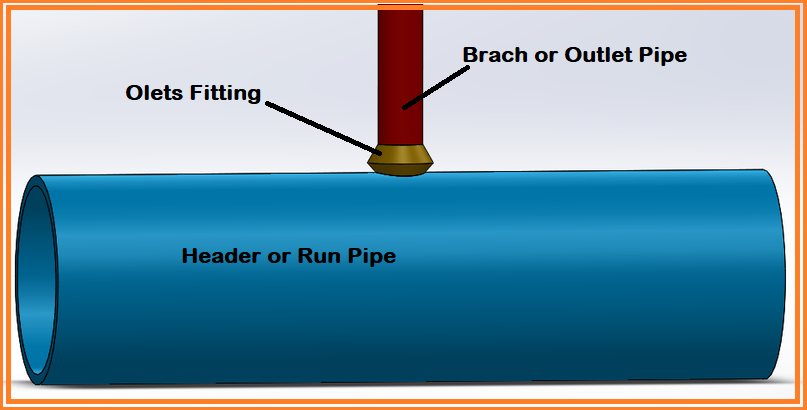
Table of Contents
Branch Connection Types
Branch connection is not new to us, as we all know standard tee and the fabricated joints (stub in or stub on) have been used for branching. But, the olets fittings have advantages over conventional pipe branch fittings. I am going to describe all the important points in this article, that must be known to the piping professionals.
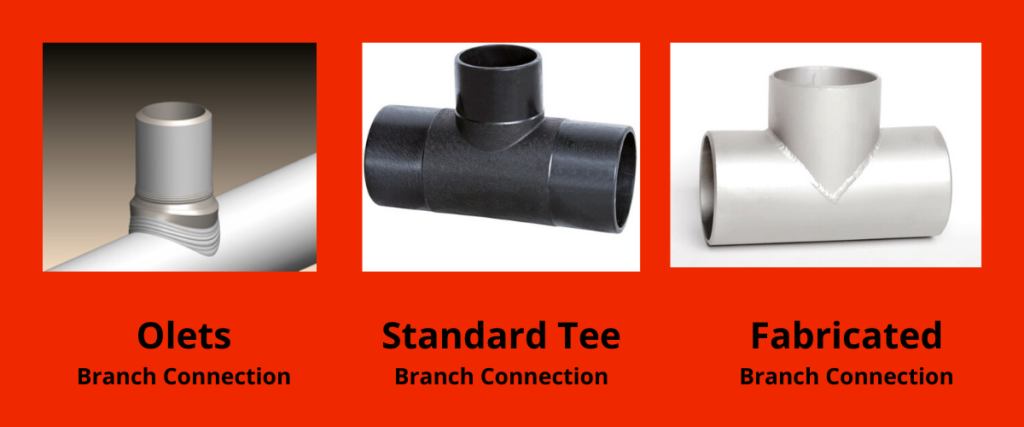
Why To Prefer Olets Fittings Over Conventional Branch Connection?
There are many advantages of using Olets fittings over a standard tee and fabricated joint. I have mentioned some of them below-
- Olets fittings can withstand high-pressure whereas fabricated joints are not preferred for high-pressure line
- Only 2 welds are needed in Olets fitting whereas for standard tee numbers of the weld are 3
- It required less installation time
- Inspection is easy
- Required less space, which makes the piping system more flexible
- There is no restriction to flowing fluid, due to the fine design
- Welding is easy as compared to standard tee
- It can easily be installed on the pipe rack
- Reinforcing Pad is not required, as it is self-reinforced fitting
- Required less material removal from the header or run pipe, which maintains the strength in the header.
We are not going to dig deeper into the other branch connection types, for now, our focus is on Olets fittings. But, a short glimpse was required for clarification and to differentiate the olets fittings and conventional branch connection. Let’s see the main types of olets fittings below-
Olets Fitting Types
Most commonly used Olets fittings types are as follows-
- Weldolet
- Sockolet
- Thredolet
- Sweepolet
- Latrolet
- Flangolet
- Nipolet
- Coupolet
- Elbolet
- Insert Weldolet
- Brazolet
Further, we will learn about the design, application and size range of all the most commonly used Olets fittings
Weldolet
Weldolets are the most commonly used among all the olets fittings, and are well-suited for high-pressure applications. A Weldolet makes a 90° branch connection and available in full size or reducing for a straight piece of pipe. It is designed to minimize stress concentrations and provide integral reinforcement, due to its self-enforced design. Weldolet ends are beveled types, and therefore the weldolet is considered a butt-weld fitting.
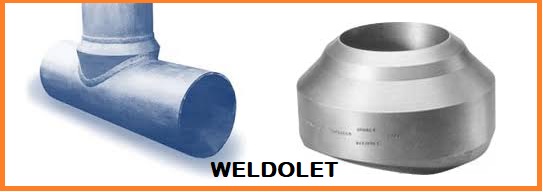
- END – Bevel end
- Branch Pipe End – Bevel end
- Size Range – 2″ – 24″
- Most commonly size range used in the industry – 2″ – 8″, (economical size range)
- Thickness/Schedule – same as the pipe
Sockolet
A Sockolet is the same as Weldolet, with the difference that the branch pipe end will be the plain end, as the Sockolet has socket weld end. Sockolets are used to make a 90° pipe branch. It is used in small size pipe and the line with low-pressure. Fillet welds are used to connect the branch pipe to the Sockolet. On the pipe header side, a Sockolet requires a welded connection same as Weldolet.
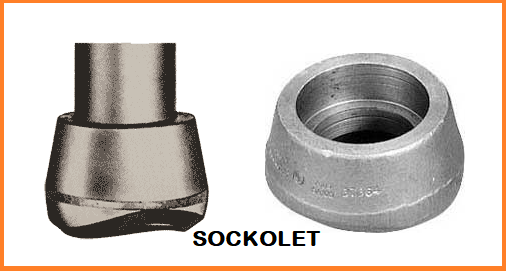
- END – Socket type
- Branch Pipe End – Plain end
- Size Range – 1/2″ – 4″
- Most commonly size range used in the industry – 1/2″ – 2″, (Safe size range)
- Thickness/Schedule – 3000#, 6000# and 9000# (ratings for socketweld fittings)
Thredolet
A Threadolet is similar to a sockolet and weldolet and makes the 90° branch. However, the main difference is the sockolet fitting has a female threaded end, and the branched pipe or Instruments are screwed on the fitting. The branching is possible of the same size or reducing.
Threadolet end is generally NPT type (National Pipe Thread) and comes under Americal standards. The end preparation is done under ASME B1.20.1 specification
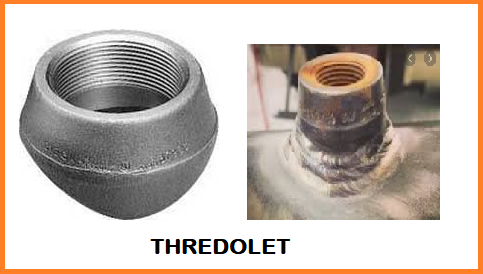
- END – Female Threaded
- Branch Pipe End – Male threaded
- Size Range – 1/2″ – 2″
- Thickness/Schedule – 2000#, 3000# and 6000# (ratings for threaded fittings)
Sweepolet
A Sweepolet is a contoured, integrally reinforced, branch connection with a low-stress escalation factor. It has low stresses and long fatigue life.
Okay! getting confused..? Do not worry, I have clarified below-
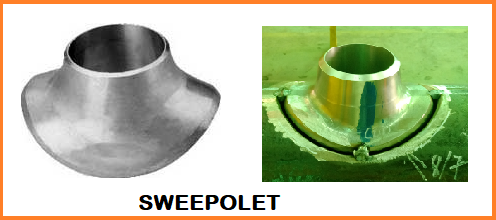
- Where to use – Normally used, if the header is above 24″ NPS and Branch is above 8″ NPS (It is not fixed, it can vary company to company)
- It is used for reducing pressure drop and for free-draining of fluid
- Used in radiography requirement
- END – Bevel end
- Branch Pipe End – Bevel end
- Size Range – 8″ – 24″ (It is mostly used size range)
- Thickness/Schedule – Same as the pipe/Schedule Number
Latrolet
Latrolet is the only one Olets fittings which provide 45° lateral branch connections, As opposed to the typical 90° branch connection. Latrolets fittings are available with multi-end connections.

- END – Female Threaded, Socket Weld, and Bevel end
- Branch Pipe End – Male Threaded, Plain, and Bevel end
- Size Range – 1/2″ – 2″ NPS (for threaded and socket weld end)
- Size Range – Above 2″ NPS (for threaded and socket weld end)
- Thickness/Schedule – 3000# and 6000# (for socket and threaded end) , and for Bevel end thickness will be same as pipe or system rating
- Bevel/butt weld fittings can be used below 2″ NPS (for food, pharma, and corrosive fluid)
Flangolet
Flangolets are the fittings, which are used for joining large-bore header and flanged end components. Breaker flange can also use joined with Flangolet if the line required frequent maintenance.
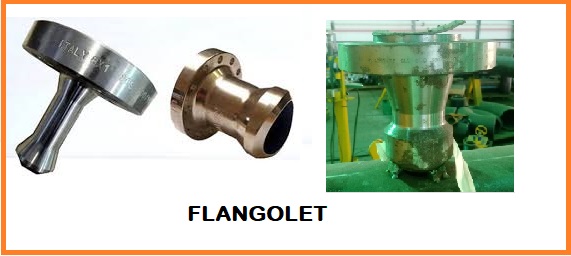
- END – Flanged end
- Branch component End – Flanged end
- Size Range – 1/2″ – 24″ (Normally available)
- Rating – 150#, 300#, 600#, 900#, 1500#
- Flange End preparation- ASME B16.5
Nipolet
Nipolets are the fittings, which are used for joining plain end large-bore header and small-bore thread end branch. It is mostly used for valve take-off, high-point vent and low-point drain system. A Nipolet is welded onto the header or run pipe, end is prepared with socket weld or threaded outlets on the branch pipe side.
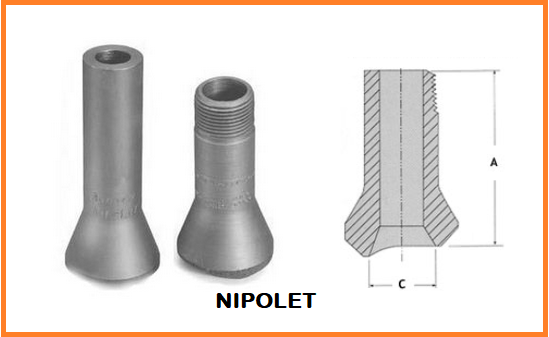
- END – Female threaded or Socket weld end
- Branch component End – Male threaded or Plain end
- Size Range – 1/2″ – 2″ (preferred size range)
- Rating – 3000#, 6000#
Coupolet
Coupolet fittings are similar to thread end half coupling, designed for use in fire protection sprinkler systems and other low-pressure piping systems.
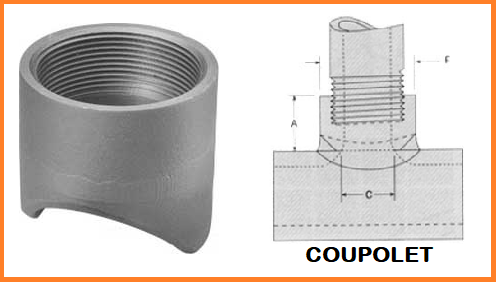
- END – Female threaded end
- Branch component or fire sprinkler End – Male threaded end
- Size Range – 1/2″ – 2″ (preferred size range)
- Rating – can be use up-to maximum of 300#
- Thickness/Schedule – 2000# 3000# and 6000#
Elbolet
An elbolet fitting is used on a 90° long radius elbow (most commonly used), short radius elbows (rare used), and can be used on 180° returns. It is typically used for instrument and thermowell connections. Elbolets fittings can be used as a drain connection, if there is not enough space to use a Weldolet. The Elbolet is available with buttweld, socket weld, and threaded end connections.
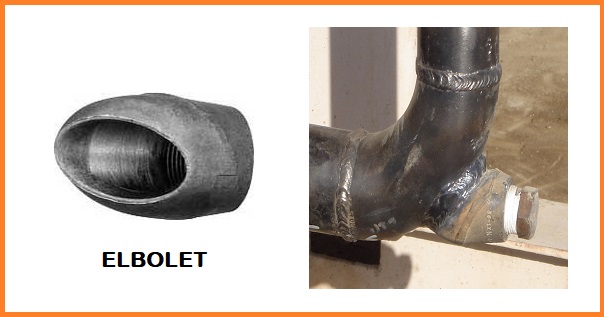
- END – Female Threaded, Socket Weld, and Bevel end
- Branch Pipe or Instrument End – Male Threaded, Plain, and Bevel end
- Size Range – 1/2″ – 2″ NPS (for threaded and socket weld end)
- Size Range – Above 2″ NPS (for threaded and socket weld end)
- Thickness/Schedule – 3000# and 6000# (for socket and threaded end),
- Rating for Buttweld end – same as piping system
Inserted Weldolet
Insert Weldolet fitting is another contoured butt-weld branch connection fitting similar to Sweepolet. But, used in less critical applications. Welding joints are easily examined by radiography, ultrasound, and other standard non-destructive techniques.
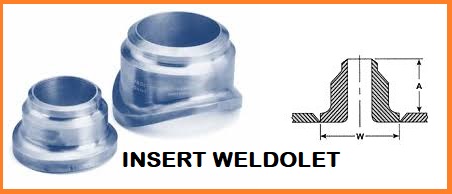
- END – Bevel end
- Branch Pipe End – Bevel end
- Size Range – 8″ – 24″ (mostly used size range), but the piping system should be less critical
- Thickness/Schedule – Same as the pipe/Schedule Number
Brazolet
Brazolet fittings are designed for the application with KLM and IPS brass or copper tubing. This fitting is Available with a socket or threaded end connections.

Weldolet Installation Procedure
Weldolet, Sockolet, Thredolet, Latrolet, Elbolet, Nipolet, Sweepolet, Brazolet, Coupolet (these all Fittings) are trademarks registered ® for the exclusive use of Bonney Forge.
You can get the same kind of fittings from other manufacturers, but with different name. We (the engineers) must review the fittings, as the fittings should meet the requirements of the related codes and standards.
Data Required for Ordering Branch Fittings
Manufacturer of Olets fittings, and other branch fittings are needed the following data/information to identify the required product:
- Header or run pipe size
- Branch or outlet pipe size
- Branch pipe schedule (required for buttweld end connection fittings) and rating (required for socket weld and NPT threaded Olets fittings)
- Types of Olets fittings (like: Weldolet, Thredolet, Nipolet, Sockolet, etc.)
- MOC (Materials of Construction)
Materials of Construction
Followings are the list of most commonly used materials for Olets fittings-
- A105 – For Carbon Steel (CS) Olets Fittings
- A350 Gr. LF2 – For Low-Temperature Carbon Steel (LTCS)Olets Fittings
- A182 Gr. F11, A182 Gr. F22, A182 Gr. F5, A182 Gr. F9, A182 Gr. F91, A182 Gr. F92 – For Low Alloy Steel (LAS)
- A182 Gr. F304, A182 Gr. F316, A182 Gr. F321, A182 Gr. F347 – Stainless Steel (SS)
Important Note: All the Olets Fittings are Forged Fittings
Codes and Standards
I have listed some important codes and standards below-
- MSS-SP-97 – Manufactured Standard Society – Special Practices – Used for Dimensioning
- ASME B16.9 – For Buttweld Fittings
- ASME B16.11 – For Threaded and Socket weld Fittings
- ASME B16.25 – Foe Buttweld/Bevel End Preparation
- ASME B1.20.1 – For Thread End Preparation
- ASME B16.5 – For Flanged End Fittings
I hope, you got the basic and important idea about the Olets fittings. The points discussed in the above article is not limited to these points only, It can vary project to project, and as per the different practices in the industry.
Reference(s)
www.steelavailable.com
www.wermac.org
www.blog.projectmaterials.com
https://chinesefittings.en.made-in-china.com/
You may also like
A Presentation on Pipe Stress Analysis
Control Station and Control Valve in the Process Piping

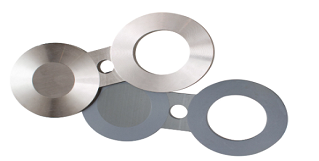
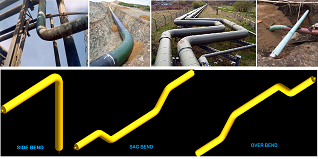
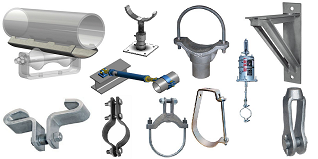
this Site is very important for updating me as a professional!!
Asalamalykum..
Rehan,
first of all thank you for pipe rack piping design information upload in site,
I need some help from your side for ongoing project work,
Can you have flare stack piping layout in plant related information,
As thumrul flare piping size, slope requirement and other information,
Can you give me Drums, Pumps, exchanger, furnace, Reactor, towers and underground easy way piping
information,
Best Regards,
Iftekhar Momin
Wa Alaikum Assalam!
Dear Iftekhar, I don’t have ready-made material to share with you. But, Soon, I will write an article on your suggested topic.
Thank you!